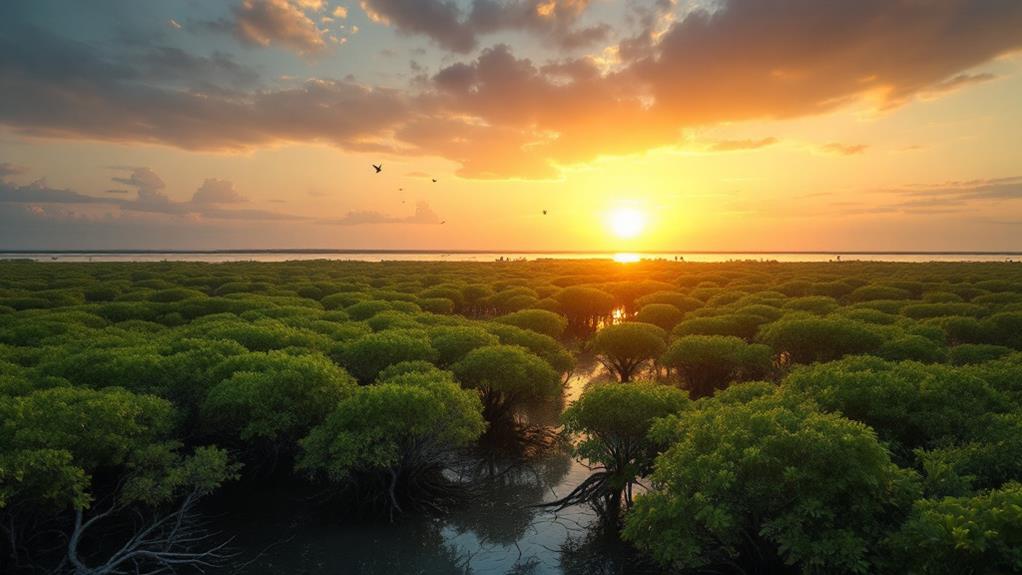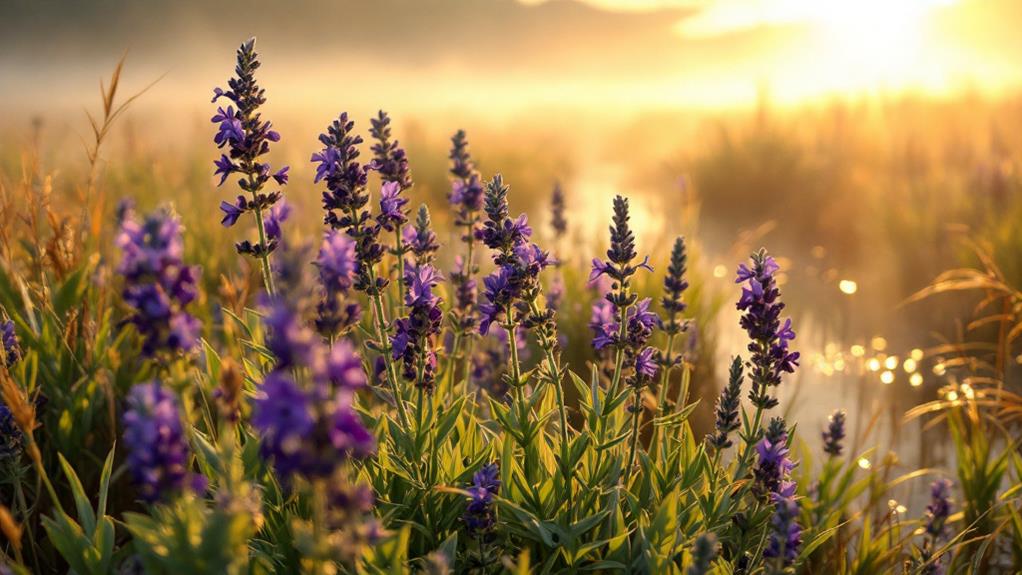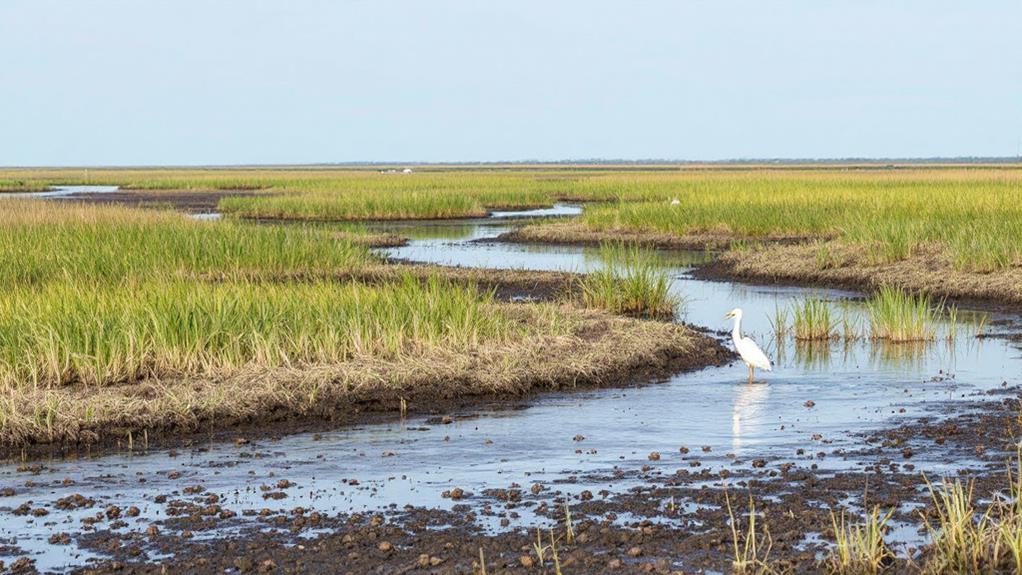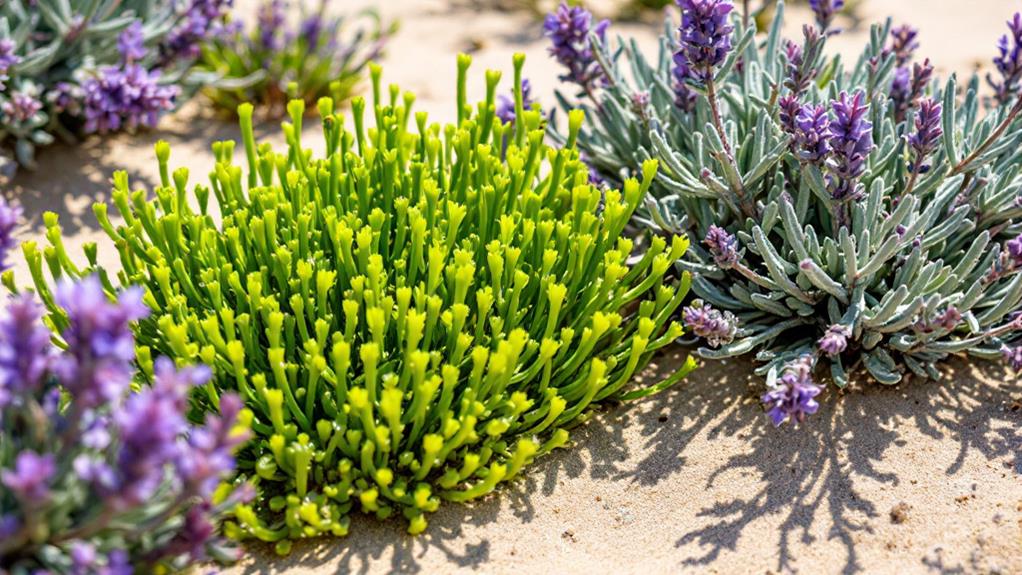Halophytes are remarkable salt-tolerant plants that thrive in saline environments. You’ll find diverse examples across various ecosystems. Mangroves act as coastal guardians, forming dense forests along tropical shorelines. Salicornia, or sea beans, are edible salt accumulators found in salt marshes. Sea lavender adds colorful beauty to coastal areas, while saltbush survives in arid lands. Cordgrass plays an essential role in tidal ecosystems, helping to build up marsh surfaces. These adaptable plants showcase nature’s resilience, with over 2,000 species worldwide. Exploring their unique characteristics reveals a fascinating world of salt-loving flora.
Mangroves: Coastal Guardians

Mangroves’ unique adaptations make them true coastal guardians. These remarkable halophytes thrive in saline environments where most plants would perish. You’ll find mangroves along tropical and subtropical coastlines, forming dense forests that serve as natural barriers against storm surges and erosion.
One of the most striking features you’ll notice about mangroves is their elaborate root systems. These roots, often visible above the water, help stabilize the trees in soft, muddy soils. They’re also equipped with specialized structures called lenticels, which allow them to breathe in oxygen-poor environments.
You’ll be amazed by mangroves’ salt management techniques. Some species have salt-filtering roots that prevent most salt from entering the plant, while others excrete excess salt through their leaves. This ability to cope with high salinity is essential for their survival in coastal areas.
Mangroves don’t just protect themselves; they’re also important for coastal ecosystems. You’ll find that these trees provide habitat for numerous species, from fish and crustaceans to birds and mammals. They’re essential nurseries for many marine organisms, supporting biodiversity and fisheries.
Moreover, you’ll discover that mangroves are powerhouses of carbon sequestration. They can store up to four times more carbon than other tropical forests, making them significant allies in the fight against climate change.
Despite their importance, mangrove forests face threats from human activities. You can help protect these coastal guardians by supporting conservation efforts and sustainable coastal development practices.
Salicornia: Edible Salt Accumulators
Among the fascinating halophytes you’ll encounter, Salicornia stands out as a unique and edible salt accumulator. This succulent plant, often called sea beans or glasswort, thrives in salt marshes and coastal areas worldwide. You’ll find Salicornia growing in dense clusters, with its bright green, jointed stems resembling miniature cacti.
Salicornia’s exceptional ability to tolerate high salinity makes it a valuable plant for both ecological and culinary purposes. It accumulates salt in its tissues, which gives it a naturally salty flavor. You can eat Salicornia raw or cooked, adding a crisp texture and briny taste to salads, stir-fries, and seafood dishes.
The plant’s salt tolerance mechanisms are impressive. It uses specialized glands to excrete excess salt and maintains a high internal osmotic pressure to prevent water loss. You’ll notice that Salicornia’s stems are fleshy and succulent, allowing it to store water efficiently.
Salicornia isn’t just a culinary delight; it’s also gaining attention for its potential in sustainable agriculture. You can cultivate it using seawater irrigation, making it a promising crop for arid coastal regions. Some researchers are even exploring its use in biofuel production and as a natural source of salt.
When you’re foraging for Salicornia, look for it in tidal flats and salt marshes during spring and summer. Remember to harvest sustainably, taking only what you need and leaving plenty for wildlife and ecosystem balance. With its unique adaptations and versatile uses, Salicornia exemplifies the remarkable resilience of halophytes in challenging environments.
Sea Lavender: Colorful Salt Marshes

While Salicornia adds a salty crunch to coastal landscapes, sea lavender paints salt marshes with vibrant hues. You’ll find these stunning halophytes, scientifically known as Limonium, thriving in coastal areas worldwide. Sea lavender’s ability to tolerate high salt concentrations makes it a perfect fit for salt marshes and other saline environments.
As you explore salt marshes, you’ll notice sea lavender’s distinctive features. Its leathery, spoon-shaped leaves form a basal rosette, while delicate flowers bloom atop tall, branching stems. The flowers range in color from lavender and purple to pink and white, creating a mesmerizing display against the backdrop of green marsh grasses.
Sea lavender’s salt tolerance comes from various adaptations. It can exclude salt at the root level, secrete excess salt through specialized glands, and compartmentalize salt within its cells. These mechanisms allow it to flourish where other plants struggle.
You’ll find sea lavender useful beyond its aesthetic appeal. It’s popular in dried flower arrangements due to its long-lasting blooms. Some species have medicinal properties, used traditionally to treat various ailments. In coastal ecosystems, sea lavender plays an essential role in stabilizing soil and providing habitat for wildlife.
As climate change threatens coastal areas, sea lavender’s importance grows. Its salt tolerance and ability to withstand occasional flooding make it a valuable tool in coastal restoration projects. By studying and preserving these colorful halophytes, you’re contributing to the protection of vulnerable coastal ecosystems.
Saltbush: Arid Land Survivors
Saltbush, a resilient halophyte, thrives in some of the world’s harshest environments. You’ll find these tough plants in arid and semi-arid regions across the globe, from the Australian Outback to the North American deserts. Saltbush, or Atriplex, comprises over 250 species, each adapted to survive in salt-laden soils where other plants would wither and die.
These remarkable plants have evolved unique mechanisms to cope with high salinity. They’ve developed specialized salt glands in their leaves that excrete excess salt, maintaining a delicate balance within their tissues. You’ll often notice a silvery sheen on saltbush leaves, which is actually a layer of salt crystals that helps reflect sunlight and reduce water loss.
Saltbush plays an essential role in its ecosystem. It stabilizes soil, prevents erosion, and provides food and shelter for wildlife. In many regions, it’s an important fodder for livestock, especially during droughts when other vegetation is scarce. Some species, like the four-wing saltbush, can even be used for human consumption.
You can use saltbush in landscaping to create low-maintenance, drought-resistant gardens. It’s particularly useful for coastal areas or regions with poor soil quality. When you’re planting saltbush, guarantee good drainage and avoid overwatering. These hardy plants prefer to be left alone to do what they do best: survive in challenging conditions.
Cordgrass: Tidal Ecosystem Engineers

Moving from the arid landscapes where saltbush thrives, let’s explore the coastal wetlands dominated by another remarkable halophyte: cordgrass. You’ll find these resilient plants thriving in salt marshes, tidal flats, and estuaries worldwide. Cordgrass, primarily of the genus Spartina, plays an essential role in shaping and maintaining these dynamic ecosystems.
As you walk through a salt marsh, you’ll notice cordgrass’s long, narrow leaves and dense growth habit. This structure allows it to withstand daily tidal flooding and trap sediment, gradually building up the marsh surface. You’re witnessing nature’s own coastal engineering in action.
Cordgrass species vary in their salt tolerance and habitat preferences. Smooth cordgrass (Spartina alterniflora) dominates the low marsh, while saltmeadow cordgrass (Spartina patens) thrives in the high marsh. These plants have adapted to thrive in saline conditions that would kill most other vegetation.
When you look closely, you’ll see how cordgrass benefits its ecosystem. Its roots stabilize the soil, preventing erosion and creating a buffer against storm surges. The plants also provide shelter and food for various wildlife, from crabs and snails to birds and fish.
However, cordgrass can become invasive when introduced to new areas. In some regions, you’ll find efforts to control its spread to protect native ecosystems. Despite this, cordgrass remains a significant component of many coastal habitats, showcasing the remarkable adaptability of halophytes in challenging environments.

Erzsebet Frey (Eli Frey) is an ecologist and online entrepreneur with a Master of Science in Ecology from the University of Belgrade. Originally from Serbia, she has lived in Sri Lanka since 2017. Eli has worked internationally in countries like Oman, Brazil, Germany, and Sri Lanka. In 2018, she expanded into SEO and blogging, completing courses from UC Davis and Edinburgh. Eli has founded multiple websites focused on biology, ecology, environmental science, sustainable and simple living, and outdoor activities. She enjoys creating nature and simple living videos on YouTube and participates in speleology, diving, and hiking.

